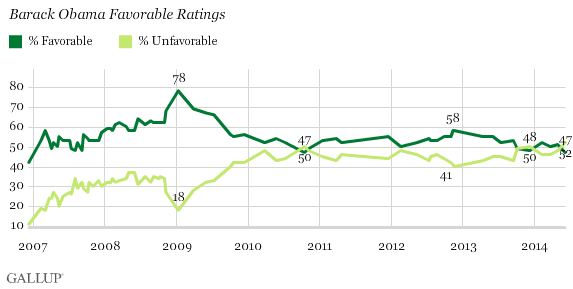PRINCETON, NJ -- Americans' views of President Barack Obama as a person have turned slightly negative, with 47% saying they have a favorable opinion of him and 52% an unfavorable one. That net favorable rating of -5 is the least positive personal assessment of Obama to date.

Americans have generally maintained a positive opinion of Obama personally throughout his presidency even as his job approval ratings have averaged no higher than 48% in each of his last four years in office. In addition to the current June 5-8 favorable ratings, there have been only three other times when his favorable rating did not exceed his unfavorable rating: once in October 2010, just prior to that year's midterm elections, and twice in late 2013 during the troubled rollout of major provisions of the Affordable Care Act.
In recent weeks, the president has been dogged by a scandal involving medical care for U.S. military veterans at Veterans Affairs hospitals as well as the controversy surrounding the release of Army Sgt. Bowe Bergdahl. These events to date do not appear to have dragged down his job approval rating in Gallup Daily tracking. However, they may be having a slight negative impact on his personal image.
In addition to his lower favorable rating, Americans now rate Obama less positively on each of six personal characteristics Gallup asked about than they did last year. The declines are not large, ranging from two percentage points on being "a strong and decisive leader" since last November to six points on "understanding the problems Americans face in their daily lives." But on all six dimensions, the public's ratings of Obama are now below the majority level and are the worst Gallup has measured for him to date.

Americans are most likely to say Obama understands the problems Americans face in their daily lives (48%), that he is honest and trustworthy (47%), and that he is a strong and decisive leader (45%). They are less likely to say he shares their values (43%), can manage government effectively (39%), and has a clear plan for solving the country's problems (34%).
By comparison, his ratings on four of these characteristics measured in April 2009, roughly 100 days into his presidency, ranged from 60% for shares your values to 73% for being a strong and decisive leader.
Implications
Recent controversies may be taking a modest toll on President Obama, but more so on his personal ratings than in evaluations of the job he is doing as president. While his favorable rating and assessments on six different personal dimensions are the lowest to date, his job approval rating is still a few points above his personal lows.
To some degree, an improving economy may be holding up his job approval rating and offsetting any potential negative effect from the VA and Bergdahl situations. Still, his average 44% job approval rating since April is not particularly good. Given the strong influence that presidential approval has on midterm election outcomes, Democratic candidates face a strong headwind as they campaign in this year's elections.
Survey Methods
Results for this Gallup poll are based on telephone interviews conducted June 5-8, 2014, with a random sample of 1,027 adults, aged 18 and older, living in all 50 U.S. states and the District of Columbia.
For results based on the total sample of national adults, the margin of sampling error is ±4 percentage points at the 95% confidence level.
Interviews are conducted with respondents on landline telephones and cellular phones, with interviews conducted in Spanish for respondents who are primarily Spanish-speaking. Each sample of national adults includes a minimum quota of 50% cellphone respondents and 50% landline respondents, with additional minimum quotas by time zone within region. Landline and cellular telephone numbers are selected using random-digit-dial methods. Landline respondents are chosen at random within each household on the basis of which member had the most recent birthday.
Samples are weighted to correct for unequal selection probability, nonresponse, and double coverage of landline and cell users in the two sampling frames. They are also weighted to match the national demographics of gender, age, race, Hispanic ethnicity, education, region, population density, and phone status (cellphone only/landline only/both, and cellphone mostly). Demographic weighting targets are based on the most recent Current Population Survey figures for the aged 18 and older U.S. population. Phone status targets are based on the most recent National Health Interview Survey. Population density targets are based on the most recent U.S. census. All reported margins of sampling error include the computed design effects for weighting.
In addition to sampling error, question wording and practical difficulties in conducting surveys can introduce error or bias into the findings of public opinion polls.
View survey methodology, complete question responses, and trends.
For more details on Gallup's polling methodology, visit www.gallup.com.
